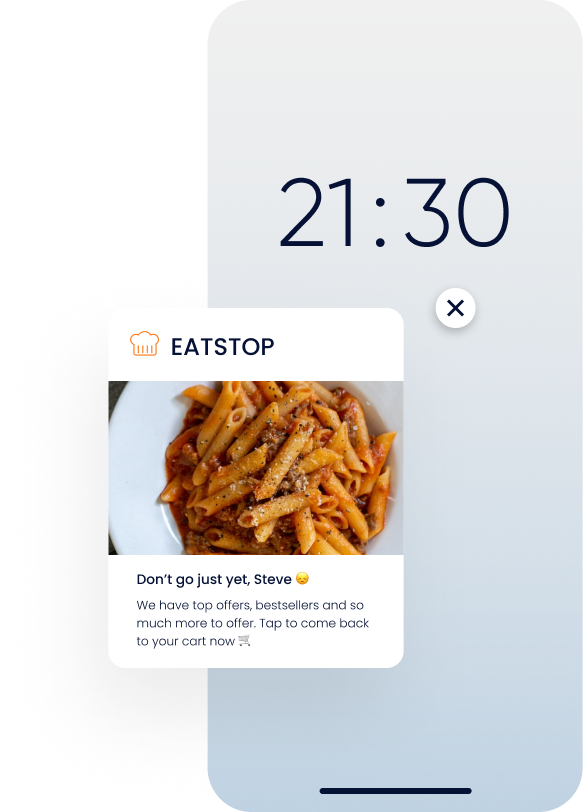6 strategies to increase revenue with cross-channel product recommendations
 Neeraj Manivannan
Neeraj Manivannan
May 30, 2022
 Neeraj Manivannan
Neeraj Manivannan
May 30, 2022
 Neeraj Manivannan
Neeraj Manivannan
May 30, 2022
 Neeraj Manivannan
Neeraj Manivannan
May 30, 2022
Personalized product recommendations for the win
Start deploying personalized product recommendations across channels to ramp up your sales
Frequently Asked Questions About Product Recommendations
Building cross-channel marketing campaigns has become a necessity for today’s brands if they are to maximize engagement, conversions, and retention. With customers active on multiple channels across devices, it is now essential for marketers to analyze which channels to use to engage them, and to understand when the time is right to use these channels effectively.
It is no secret that customers love individualized shopping experiences. They seek personalized product recommendations at each stage of the journey to enhance product discovery, making their shopping experience easier. The emphasis is now on marketers to nurture the customer’s interest and nudge them closer to purchase.
Insider’s cross-channel journey orchestrator, Architect, helps you create one-to-one customer experiences across every touchpoint. You can engage your customers on their preferred channels based on their previous interactions, interests, and affinities. You can also take this further by showing each customer personalized recommendations based on their activity or historical behavior. With personalized content, you can up-sell and cross-sell relevant products to encourage them to purchase more. You can also re-engage users by recommending relevant products on the completion of a purchase, or remind them of products that have been abandoned after browsing or after being added to the cart.
By delivering personalized recommendations with dynamic content across messaging channels, you can drive better engagement and a higher rate of conversions. You can send out recommendations on any of the following channels: Web Push, App Push, Email, SMS, and WhatsApp.
Let’s see how you can boost your cross-channel personalized marketing strategy by showing contextually relevant product recommendations to encourage your customers to shop more.
Up-selling is a marketing technique where the user is subtly nudged to buy a more expensive product by showing that it offers more value. The primary goal is to increase the Average Order Value (AOV) by getting the user to buy an expensive alternative. For example, when a customer is looking to buy a mobile phone, electronics suppliers can show recommendations of higher priced mobiles with better features. By highlighting the benefits of the upgraded specifications offered by the costlier phone, brands can encourage customers to purchase the product at a higher price.
You can subtly up-sell your products by showing recommendation widgets like ‘You May Also Like’ and ‘Personalized for You’. By showing superior products as personalized product recommendations, you can induce a sense of pride in your customers’ hearts.

Here’s an app push message sent by an eyewear retailer nudging the customer who has recently purchased a pair of spectacles to buy a premium brand of sunglasses.
Cross-selling is a clever marketing strategy where you suggest supplementary products that can be purchased along with the product the user is looking to buy. An intelligent AI-powered recommendation engine can assess the previous browsing history and real-time behavior of the user to provide accurate recommendations that users can use with the product they’re planning to purchase. For example, if a user is buying a football jersey on a sports store’s app, you can recommend shorts, socks, and other merchandise products related to the same team for them to buy along with the jersey.
Cross-selling can be done in real time while a customer is browsing through your products on your website or mobile app by showing recommendation widgets like ‘Frequently Bought Together’ and ‘Goes Well With’. By cross-selling, brands can improve their average order value right away. But it doesn’t end there, as brands can continue engaging their customers even after they’ve completed the purchase through other marketing channels like email, SMS, WhatsApp and push notifications. By showing eye-catching recommendations, you can pull your users back to your website or mobile app.
Here’s an on-site pop-up that nudges the user to buy a meal instead of purchasing a burger by itself. Customers often go ahead and order a meal, as it offers a more satisfying experience.
The accuracy of recommendations is key to the success of your cross-sell strategy. Cross-selling is a great strategy to increase your sales and Average Order Value.
Browse abandonment is a common phenomenon observed on e-commerce websites as customers often visit a website without intent to purchase. Their aim is simply to browse through products to see if they come across something interesting, and drop off without adding anything to their cart or making a purchase.
However, while browsing through the website or mobile app, customers give indications of products that interest them. AI-powered predictive technologies help marketers understand these intricate customer affinities and can be used to retarget customers with personalized recommendations on channels like push notifications, email, SMS, and WhatsApp even after the customer has exited the platform. This way you can drive them back to your website or mobile app and nudge them towards purchase.
Here’s an example of an apparel brand sending out a SMS to remind the shopper of products that were browsed in their previous session. To generate additional interest, they have also moved viewed products to the wishlist section.
Check out how HipVan achieved a conversion rate uplift of 46.7% by crafting personalized browse abandonment journeys.
Cart abandonment is a frustrating scenario for e-commerce marketers as it indicates that customers have shown interest in buying something on your platform but then dropped off without completing the purchase. Tackling cart abandonment is a key element in boosting conversions and revenues.
Re-engaging users who have abandoned their cart is a must-have strategy to boost your conversions, as these are the customers who have already shown a clear interest in buying. Sending out a cart abandonment message as a reminder shortly after customers exit your platform is an excellent way to pull them back and nudge them towards conversion. Having these same products ready in the cart when they return increases convenience for the user and takes them even closer to purchase.

Here’s a push notification reminding the user of the food items that the customer had added to their cart.
Check out how Marks & Spencer increased its cart recovery rate to 15.1% by sending out personalized web push notifications.
The customer journey doesn’t end once the user makes a successful purchase. The key to increasing revenues is customer retention. It is not sufficient to only communicate with your users until they make the purchase, as nurturing a long-term relationship is even more important. A well-defined post-purchase strategy is essential to effectively engage and retain customers.
Thanking your customers for the purchase, getting their feedback, and understanding other requirements they have are steps toward creating a strong bond. You can take this a step further by taking the opportunity to show them recommendations for products related to their previous purchases. This way you can cross-sell products that compliment their previous purchase. If the product purchased was something at risk of running out of stock, you can prompt your users to repurchase within a period of time, beyond which the product may no longer be available.
Here’s an email reminding your user to purchase a product that might soon be out of stock.
We’ve already seen the importance of customer retention. Acquiring new customers is five times more expensive than retaining existing customers. You will want to hang on to a customer once you have gone through the trouble (and expense) of acquiring them.
Customers often drift away and stop responding to your communications. When this happens, it is critical to be aggressive and calculative in your efforts to win them back. Personalized communication across multiple channels is the way to re-engage them.
If your customer hasn’t uninstalled the app, but hasn’t visited your website or app for a sustained period of time, you could trigger personalized app push notifications to regenerate interest. If this still doesn’t work, sending personalized emails or WhatsApp messages are great techniques to grab eyeballs and pull your dormant customers back onto your website or app.
If a customer has already shown interest in your products and services, there’s no reason for you to let them go. If they haven’t visited for a while, showing personalized product recommendations based on their previous browsing history will be a great way to capture their attention.

Here’s a WhatsApp message that has been sent by a brand on the special occasion of Valentine’s Day aiming to encourage the customer to return to the platform to shop for their loved ones. Along with personalized product recommendations, they’re offering personalized discounts to give the customer an additional incentive to make a purchase.
Check out how Samsung achieved a 24% increase in cart recovery rate using Insider’s Web Push by re-engaging lost customers.
With Insider’s cross-channel journey orchestrator, Architect, you can easily build individualized cross-channel journeys that help you grow and retain your customers better. Serving up personalized product recommendations goes a long way to creating additional interest and is a great way to boost conversions. All of these strategies can be done effortlessly using Architect.
Many brands have reaped the benefits offered by our AI-powered personalized product recommendations in their campaigns and have observed uplifts in conversion rate and revenues, while achieving great ROI.
To learn more about how you can scale your digital and mobile marketing strategy with Architect, get in touch with us today!
Product recommendations are the technique of showing customers recommendations of products that are likely to interest them and making it easier for them to discover new products to help increase online store sales. Showing relevant product recommendations increases the chances of customers purchasing the products, thereby increasing revenue.
AI-powered product recommendations use AI and Machine Learning algorithms to understand user behavior, interests, and affinities to understand the products each individual user is likely to purchase. By showing more relevant products as recommendations, the likelihood of the customers being interested in those products increases, thereby increasing the chances of purchase.
AI-powered product recommendations help create a personalized, relevant experience and boost product discovery and conversion rate. This helps in building brand credibility and trust. Showing more personalized recommendations increases Average Order Value (AOV) and encourages brand loyalty and retention. All these efforts help reduce Customer Acquisition Costs.
Today’s customers are generally present on multiple different channels, and it’s important to be present where they are to increase chances of engagement and boost brand awareness. Only through effective targeting across multiple channels that catch your users’ attention can you drive relevant content into their ears and get them to complete more purchases.
Product recommendation engines work on complete AI and ML algorithms. These algorithms consider massive amounts of customer data, including purchase history, preferences, and search and browsing behavior. These engines then analyze data about shoppers to learn exactly what types of products interest them so they can serve those recommendations across different channels and stages of a customer lifecycle.

Written by
Neeraj Manivannan
Neeraj is an inquisitive person with an interest in Marketing, new-age technologies, and analytics. Having started his professional journey in the Martech industry, he hopes to build a long career in the SaaS space. Beyond work, he's a sports fanatic who manages his own football YouTube channel and writes about other sports like cricket and F1 during his free time.